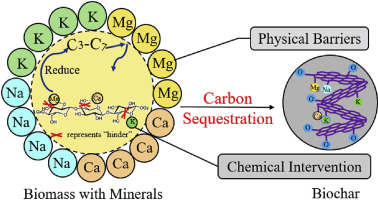Journal of Cleaner Production ( IF 9.7 ) Pub Date : 2020-01-20 , DOI: 10.1016/j.jclepro.2020.120162
Hongyan Nan , Ling Zhao , Fan Yang , Yang Liu , Ziyue Xiao , Xinde Cao , Hao Qiu

|
During the pyrolytic production of biochar, only 50% of carbon (C) could be retained in biochar, and about 10% C would be mineralized after biochar is amended into soil. In this study, we aim to search a material to pretreat the biomass and improve carbon sequestration along biochar production and application. Alkaline minerals are widely reported to have catalytic effect on biomass pyrolysis and alter the liquid and gas products, while few studies have focused on their influence on biochar C sequestration. This study selected KCl, NaCl, MgCl2, and CaCl2 to dope in a biomass, cow manure, to explore their influence on the carbon sequestration based on carbon retention before and after pyrolysis and the carbon stability assessed by K2Cr2O7 oxidation and biological mineralization in real soil. Results showed that dosage of these minerals with a mineral/biomass ratio of 1: 5 (w/w) increased C retention in biochar from 49.8% (without minerals) to 52.5% (KCl), 53.7% (NaCl), 64.1% (MgCl2), and 60.7% (CaCl2), respectively. However, only MgCl2-fixed C in the produced composite biochar (Mg-BC) exhibited significant C stability both for bulk C (about 60.0%) and surface C (5.0 mg CO2·kg−1 soil). Addition of CaCl2 also could retain more C in biochar during pyrolysis, while the C in this composite biochar was not stable indicated by K2Cr2O7 oxidation and biological mineralization. Crystals of MgO and MgO3(CO3)2 were detected on the surface of Mg-BC by X-ray diffractometer (XRD), which could sorb small organic molecules such as C3–C7 compounds from the thermal decomposition verified by thermogravimetry-mass spectrum analysis (TG-MS). Moreover, a physical barrier was formed covering on biochar surface and enhance its capacity against oxidation and biological mineralization. This study offers a potential strategy to strengthen biochar-carbon sequestration by Mg-doping from the production of biochar to the application in soil environment.
中文翻译:

在热解过程中,不同的碱性矿物与生物质碳相互作用:哪一种能改善生物炭的固存?
在生物炭的热解生产过程中,只有50%的碳(C)保留在生物炭中,在将生物炭修改为土壤后,约有10%的碳会矿化。在这项研究中,我们旨在寻找一种材料来预处理生物质并改善生物炭生产和应用过程中的碳固存。广泛报道了碱性矿物对生物质热解具有催化作用,并改变了液体和气体产物,而很少有研究集中在它们对生物炭固碳的影响上。本研究选择KCl,NaCl,MgCl 2和CaCl 2掺杂生物质牛粪中,基于热解前后的碳保留量和K 2 Cr 2评估的碳稳定性,研究它们对固碳的影响。真实土壤中的O 7氧化和生物矿化。结果表明,以矿物质/生物质比为1:5(w / w)的这些矿物质的剂量将生物炭中的碳保留率从49.8%(不含矿物质)增加到52.5%(KCl),53.7%(NaCl),64.1%( MgCl 2)和60.7%(CaCl 2)。但是,在生产的复合生物炭(Mg-BC)中,只有MgCl 2固定的C对大块C(约60.0%)和表面C(5.0 mg CO 2 ·kg -1土壤)均表现出显着的C稳定性。CaCl 2的添加还可以在热解过程中在生物炭中保留更多的C,而该复合生物炭中的C不稳定,K 2 Cr 2 O表明7氧化和生物矿化。用X射线衍射仪(XRD)在Mg-BC表面检测到MgO和MgO 3(CO 3)2晶体,该晶体可通过热重分析验证的热分解吸附诸如C 3 –C 7化合物的有机小分子。-质谱分析(TG-MS)。此外,形成了覆盖生物炭表面的物理屏障,并增强了其抗氧化和生物矿化的能力。这项研究提供了一种潜在的策略,可以通过从生产生物炭到将其应用于土壤环境中进行Mg掺杂来加强生物炭固碳。































 京公网安备 11010802027423号
京公网安备 11010802027423号